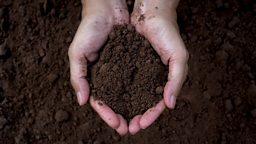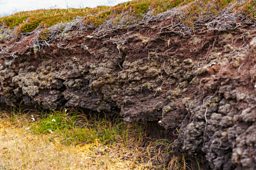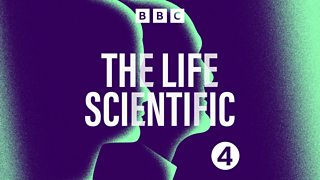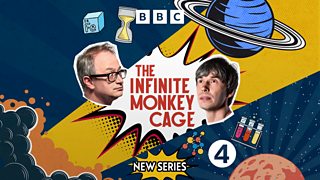How soil can help save the world
Soil science might not be the most exciting discipline you can think of, but you might be surprised at its depth. Many people – including in the science world – have underestimated what is beneath our feet but we’re now in the International Decade of Soils, where the role of soil in food security, biodiversity and climate change has been front-ended.
One of the key players in making soil "sexy" is Pete Smith, Professor of Soil and Global Change at the University of Aberdeen. For The Life Scientific, Jim Al-Khalili finds out why mud is so glorious and how it can help us fight on all these vital fronts simultaneously.

Soil is carbon’s keeper
There is twice as much carbon stored in soil as there is in all vegetation on earth – that’s trees, plants, grasses - everything.
If you can lock away carbon by managing the soils better or stop that organic matter being lost, then you can prevent CO2 getting into the atmosphere.
“You only need small changes in that large pool of carbon to cause a big impact on climate,” says Professor Smith, adding: “if you plough up your soils, you lose organic matter which contains the carbon and that can put a pulse of carbon into the atmosphere, and it's carbon dioxide in the atmosphere that's driving climate change.”
“Conversely, if you can lock away carbon by managing the soils better or stop that organic matter being lost, then you can prevent CO2 getting into the atmosphere.”
Soil science: the hidden discipline
Despite its key gatekeeping role, it’s only in the last 30 years that climate change has been looked from the point of view of soil.
“A lot of the global climate models that were working at the time when I started had a very simple representation of soils, if any representation of soils at all,” recalls Professor Smith. “They were mainly driven by atmospheric physics, and then some of the models started to consider what would happen with vegetation.”

Making a huge difference in the fight against climate change
How wetlands and peatlands store huge amounts of carbon.
The United Nations journey: IPCC and IPBES
In the late 1990s, Professor Smith was invited to be a lead author on a special report by the influential IPCC – the UN’s Intergovernmental Panel on Climate Change – on land use and forestry. Smith contributed only on soil but he had a revelation in the process. “I realised that soils aren't disconnected from everything else I knew.”
Even with Smith’s contribution, it was sometime later that biodiversity was recognised with its own panel – the Intergovernmental Science-Policy Platform on Biodiversity and Ecosystem Services (IPBES), established in 2012.
The International Year of Soils
Although some years after the Rio Summit in 1992 had identified them as priorities, platforms for tying up climate change with biodiversity and land degradation/desertification were now in place.
The International Year of Soils followed in 2015 and then the International Decade of Soils, which we are now in, both spearheaded by another UN body, the Food and Agriculture Organisation (FAO). The FAO subsequently put its own report together – the first ever global study of soil degradation.
“One of the headline indicators of degradation is the loss of organic matter,” explains Professor Smith. “That organic matter is about 50% carbon. So, for every tonne of organic matter you lose, you're losing half a tonne of carbon, which is going up as CO2 into the atmosphere. Some of the things that we would do to improve soil fertility and to prevent degradation, to prevent loss of soil through erosion, are the same things that prevent the CO2 going into the atmosphere.”
The Cinderella of climate change mitigation
While they only make up 3% of land area, wetlands and peatlands store huge amounts of carbon, more than all of the above ground carbon in the rainforest put together. “I think peatlands have been overlooked,” says Professor Smith, “they are the Cinderella of climate change mitigation.”

Scotland’s peatlands
Professor Smith has a number of key roles in Scotland including a position on the First Minister’s Environment Council, a new body set up around the time of COP COP26 in Glasgow.
David Attenborough... made people realise that biodiversity is linked to everything.
“Scotland is making big strides,” says Professor Smith, “they’ve got a peatland action plan and there's money available. In fact, there's more money available than there is people to do the work!”
With over 80% of the UK’s peatland degraded to some extent, restoring them could have a massive impact on Scotland’s greenhouse gas budget. When peatland gases were included in the national greenhouse gas inventory it took Scotland from being a "net sink" because of its forests to a "net source", because they are now degraded and releasing carbon they’ve stored for centuries into the atmosphere.
The peatland contains a huge amount of carbon because they are waterlogged. As soon as the water table is lowered, oxygen gets in, the organic matter oxidises and that CO2 goes up into the atmosphere. So, the plan is to restore those areas by raising the water table by "grip blocking", a drain that is blocked up so the peatland re-wets when it rains. The peatland starts to restore and “switches off those ongoing emissions of carbon dioxide to the atmosphere.”
Diplomacy, frustration and David Attenborough
Professor Smith doesn’t entertain any wish to jump from advisory roles to a political one. He understands why countries have to put their national interests first, especially those that are fossil fuel intensive. However, he admits to getting frustrated because “we’ve really run out of time.”
He credits David Attenborough and particularly his last series on the biodiversity crisis which “made people realise that biodiversity is linked to everything.” Meanwhile the IPBES and the IPCC have now worked together – for the first time – on a report about the interconnections between biodiversity and climate change. “The upshot is that we have to tackle them together, otherwise we fail at both.”
-
![]()
The Life Scientific: Pete Smith on why soil matters
Pete Smith is very down to earth. Not least because he’s interested in soil and the vital role it plays in helping us to feed the world, mitigate climate change and maintain a rich diversity of species on planet earth.

More science on Radio 4
-
![]()
The Life Scientific
Professor Jim Al-Khalili talks to leading scientists about their life and work.
-
![]()
What makes a good scientist?
Jim Al-Khalili celebrates 10 years of The Life Scientific by asking some great thinkers.
-
![]()
Dinosaurs becoming birds...
... like building the first aeroplane, but over millions of years.
-
![]()
The Infinite Monkey Cage
A witty, irreverent and unashamedly rational look at the world according to science, with Robin Ince and Prof. Brian Cox.




